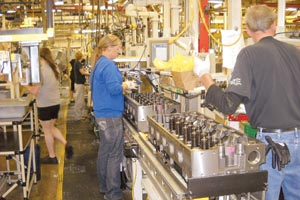Senior Reporter
Cummins to Cut Workforce as Truck Engine Sales Fall

Engine maker Cummins Inc. said last week it would reduce its workforce by 2,000 employees, or about 4% of its global payroll, and close or restructure some manufacturing facilities as a result of lower demand for its products, including truck engines.
CEO Tom Linebarger said the review would extend to all business segments.
“We expect to complete this evaluation by the end of the fourth quarter and will take actions as needed,” he said during a conference call to discuss third-quarter earnings.
Linebarger also said third-quarter shipments of heavy-duty engines in the North American market exceeded 24,000 units, but that was down 9% from a year earlier. Heavy-duty engine sales slipped 2% to $784 million from $801 million. Medium-duty engines sales, including buses, dropped 2% to $585 million.
Overall, Cummins said its quarterly net income dropped 10.2% to $380 million from $423 million in the year-earlier period. Earnings per share were $2.14, down from $2.32, while revenue fell to $4.6 billion, a decrease of 6%.
“What you will see is our [truck engine] plants are very flexible at adjusting to this [softening of market conditions],” Cummins President Rich Freeland explained, responding to an analyst’s question on truck-engine production.
“They were designed to flex quickly in weeks and months, not over quarters,” he said. “So as production goes up or down, our whole system is set to flex, and so we are already doing that in our production plants.”
Cummins now projects its market share for heavy-duty engines in 2015 would be 33% to 34%, down from expectations of 36% at the start of the year.
Jamie Cook, an analyst with Credit Suisse, said the restructuring reflected Cummins’ concerns that “emerging markets, off-highway and power generation continue to find new bottoms coupled with increasing concern the best of the North American truck [market] is behind us.”
Steve Tam, vice president of ACT Research, told Transport Topics that U.S. truck makers are making efforts to increase the penetration of their own engines in their trucks.
“But you also have customers out there who are very loyal to certain components, the engine probably being the foremost, and obviously, Cummins has had a huge following in that sense,” Tam said.
However, Michael Baudendistel, an analyst with Stifel, Nicolaus & Co., said he believes Cummins’ market share will continue to decline.
He said Daimler Trucks North America and Paccar Inc. are pushing vertical integration, Navistar’s market share remains depressed and that environmental standards likely won’t alter market share trends in the near term.
Baudendistel also said Cummins’ medium-duty market share “may also have nowhere to go but down, albeit, from the current high level above 70%, as Ford pushes its vertically integrated powertrain in its Class 6 and 7 trucks.”
Ann Duignan, an analyst with JPMorgan Chase & Co., took a similar tack.
She said a “longer-term loss of share to Volvo and Freightliner could occur as both are now offering vertically integrated drivetrains as standard equipment, while share loss to [truck and] engine makers such as Paccar and Freightliner could prove to be greater than expected.”
Cummins lowered its industry outlook for sales of heavy-duty trucks in 2015 to 286,000, down from 290,000 that it projected in the second quarter.
Freeland said production backlogs for heavy-duty engines are falling, but orders to fill the slots are not keeping pace.
“And so we see some pretty near-term reductions in requirements for engines, and we saw that in Q3 and, frankly, we see that continuing into Q4 and into 2016,” he said.
“The freight market actually is pretty good,” he added, “but some of the indications . . . like truck prices, dealer inventories are up, cancellations are up a bit — there are a lot of moving pieces there.”

